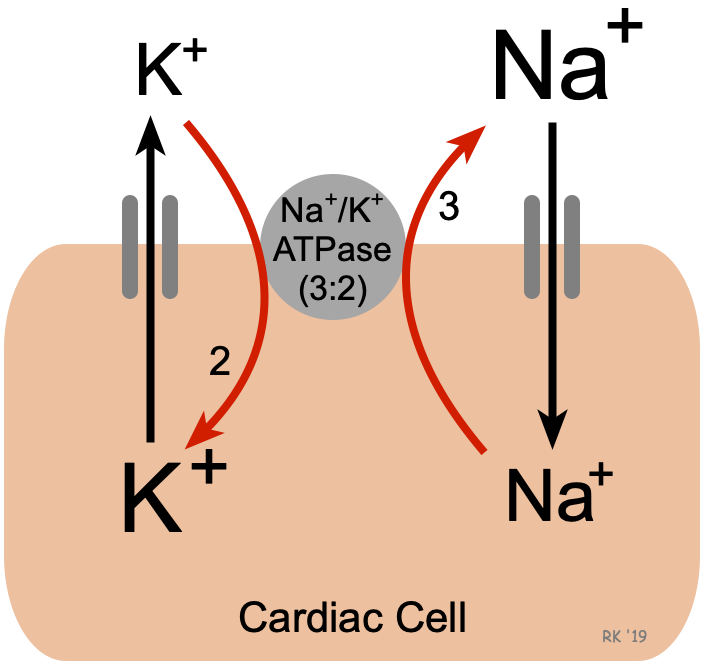Sodium-Potassium ATPase Pump
 Under resting conditions, Na+ slowly leaks into the cells and K+ leaks out of the cell because of electrochemical driving forces. Whenever an action potential is generated, additional Na+ enters the cell and K+ leaves the cell. The number of ions moving across the sarcolemmal membrane in a single action potential is minimal relative to the total number of ions; however, after many action potentials are generated, there can be a significant change in the extracellular and intracellular concentration of these ions. To maintain the concentration gradients for Na+ and K+, it is necessary to transport Na+ out of the cell and K+ back into the cell. There is on the sarcolemma an energy dependent (ATP-dependent) pump system (Na+/K+-ATPase) that performs this function. This pump is essential for the maintenance of Na+ and K+ concentrations across the membrane. If this pump ceases working (as occurs under anoxic conditions when ATP is lost), or if the activity of the pump is inhibited (as occurs with cardiac glycosides such as digoxin), Na+ accumulates within the cell and intracellular K+ falls. This causes depolarization of the resting membrane potential, as predicted by the Nernst equation, primarily because of the reduction in the potassium concentration gradient across the cell membrane. It is important to note that this pump is electrogenic in nature because it extrudes 3 Na+ for every 2 K+ entering the cell. By pumping more positive changes out of the cell than into the cell, the pump activity creates a net outward current of positive charges, which creates a negative potential within the cell. This potential may be up to -10 mV. Inhibition of this pump, therefore, causes cellular depolarization, resulting not only from changes in Na+ and K+ concentration gradients but also from the loss of an electrogenic component of the resting membrane potential. Phospholemman is a regulatory protein that is associated with this pump, and under resting conditions, partially inhibits pump activity. Sympathetic stimulation of the heart or beta-adrenoceptor activation by drugs, phosphorylates phospholemman, which partially removes its inhibitory action on the pump and increases pump activity.
Under resting conditions, Na+ slowly leaks into the cells and K+ leaks out of the cell because of electrochemical driving forces. Whenever an action potential is generated, additional Na+ enters the cell and K+ leaves the cell. The number of ions moving across the sarcolemmal membrane in a single action potential is minimal relative to the total number of ions; however, after many action potentials are generated, there can be a significant change in the extracellular and intracellular concentration of these ions. To maintain the concentration gradients for Na+ and K+, it is necessary to transport Na+ out of the cell and K+ back into the cell. There is on the sarcolemma an energy dependent (ATP-dependent) pump system (Na+/K+-ATPase) that performs this function. This pump is essential for the maintenance of Na+ and K+ concentrations across the membrane. If this pump ceases working (as occurs under anoxic conditions when ATP is lost), or if the activity of the pump is inhibited (as occurs with cardiac glycosides such as digoxin), Na+ accumulates within the cell and intracellular K+ falls. This causes depolarization of the resting membrane potential, as predicted by the Nernst equation, primarily because of the reduction in the potassium concentration gradient across the cell membrane. It is important to note that this pump is electrogenic in nature because it extrudes 3 Na+ for every 2 K+ entering the cell. By pumping more positive changes out of the cell than into the cell, the pump activity creates a net outward current of positive charges, which creates a negative potential within the cell. This potential may be up to -10 mV. Inhibition of this pump, therefore, causes cellular depolarization, resulting not only from changes in Na+ and K+ concentration gradients but also from the loss of an electrogenic component of the resting membrane potential. Phospholemman is a regulatory protein that is associated with this pump, and under resting conditions, partially inhibits pump activity. Sympathetic stimulation of the heart or beta-adrenoceptor activation by drugs, phosphorylates phospholemman, which partially removes its inhibitory action on the pump and increases pump activity.
Revised 10/27/2023

 Cardiovascular Physiology Concepts, 3rd edition textbook, Published by Wolters Kluwer (2021)
Cardiovascular Physiology Concepts, 3rd edition textbook, Published by Wolters Kluwer (2021) Normal and Abnormal Blood Pressure, published by Richard E. Klabunde (2013)
Normal and Abnormal Blood Pressure, published by Richard E. Klabunde (2013)